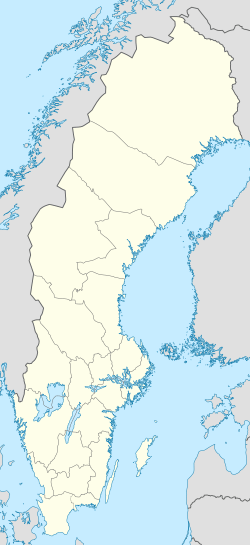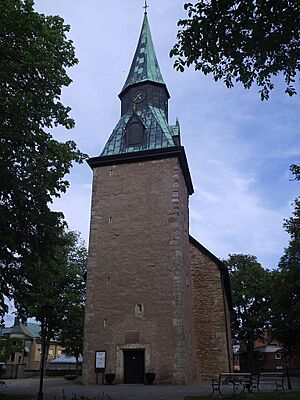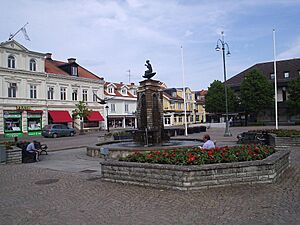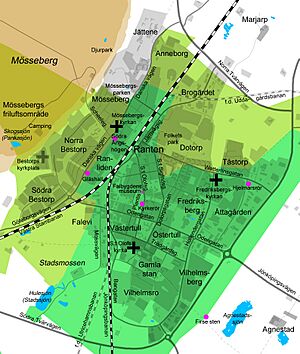Falköping facts for kids
Quick facts for kids
Falköping
|
||
|---|---|---|

Trätorget (17 June 2006)
|
||
|
||
| Country | Sweden | |
| Province | Västergötland | |
| County | Västra Götaland County | |
| Municipality | Falköping Municipality | |
| Founded | 1200 | |
| Area | ||
| • Total | 9.46 km2 (3.65 sq mi) | |
| Elevation | 218 m (715 ft) | |
| Population
(31 December 2020)
|
||
| • Total | 17 939 | |
| Time zone | UTC+1 (CET) | |
| • Summer (DST) | UTC+2 (CEST) | |
| Postal code |
521 xx
|
|
| Area code(s) | (+46) 515 | |
| Climate | Dfb | |
Falköping (Swedish pronunciation: [ˈfalɕøːpɪŋ]) is a town in Västra Götaland County, Sweden. It is the main town of Falköping Municipality. In 2010, about 16,350 people lived there.
Falköping is known for its long history. It has many ancient remains from the Stone Age, Bronze Age, and Iron Age. The town is located between two flat-topped mountains, Mösseberg and Ålleberg.
Contents
History of Falköping
The town of Falköping was first mentioned around the year 1100. It was an important place for pilgrimage (a special journey for religious reasons). This was because of its 12th-century church. This church was named after Saint Olaf.
Falköping faced tough times in the 16th century. It was even burned down by the Danish army during a war. But the town survived and was rebuilt.
Ancient Discoveries
The area around Falköping, called Falbygden, is famous for its very old remains. People have lived here since the end of the ice age. They have farmed the land for the last 6,000 years.
The oldest discovery is a type of megalithic tomb called a dolmen. This tomb dates back to 3400 B.C. There are also 28 passage graves from around 3300 B.C. These are ancient burial places.
Many cists have also been found here. These are stone-lined burial chests. They date back to the early Stone Age (2400–1500 B.C.). Experts believe they were built by or inspired by travelers from other countries. Falköping is special because it has so many visible megalithic graves.
Local Businesses
Falköping has a history of different industries. Early businesses included the Victoria Brewery (1856–1953) and Haglunds Roller blinds factory (starting 1885). Forss hat factory also opened in 1880.
In the 1900s, more companies started. These included Alton gold forgery (1928) and Falköping dairy factory (1930). The Arkivator workshop industry began in 1940. There were also sewing factories like Svaréns and Ottossons.
Modern Industries
Falköpings Mejeri (Falköping dairy factory) is a dairy company. It provides milk to stores in western Sweden. The Falbygdens Ost cheese factory makes cheese for stores all over Sweden.
A "dry port" was built recently. This is a special area connected to the railway. It helps companies in the area move goods more easily.
Geography and Travel
Falköping is located where two important train lines meet. The Western Main Line connects Stockholm and Gothenburg. Another line goes from Nässjö through Jönköping to Falköping.
It takes less than an hour by train to reach both Gothenburg and Jönköping. This makes Falköping a good place for people who travel for work or school.
Famous People from Falköping
Football player Madelen Janogy was born in Falköping. She started her football career with the local team Falköpings KIK.
Sports and Fun Activities
Falköping has many ways to enjoy sports and leisure.
Association Football
There are several football fields in Falköping. Local football clubs include:
- Falköpings KIK
- IFK Falköping
- Falköpings FK
Motor Sports
The Falköpings Motorklubb hosts car and motorbike races. These races take place at the Motorstadion. It is about 5 km west of the town. The club used to have a motorcycle speedway team called Falkarna. They raced in the Swedish Speedway Team Championship. The speedway track also hosted a big international race in 1952.
Walking Routes
There is an 8 km (5 mi) long path around the town. It is called Hälsoslingan, which means "path of health." People use it for running and walking with friends and family.
The Folk Tale of The Riders of Ålleberg
There is a local folklore story about Ålleberg mountain. The story says that if Falköping is ever in danger, the mountain will open up. A group of knight-like figures will then ride out. They will defeat the threat to the town. These figures are known as Ållebergs Ryttare, or "The Riders of Ålleberg."
See also
 In Spanish: Falköping para niños
In Spanish: Falköping para niños








